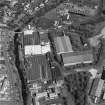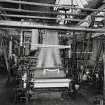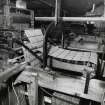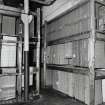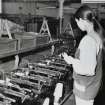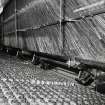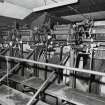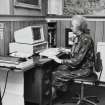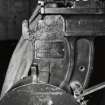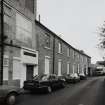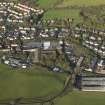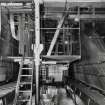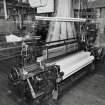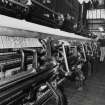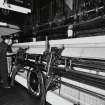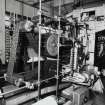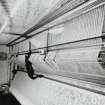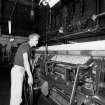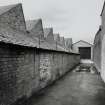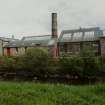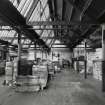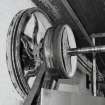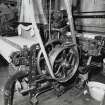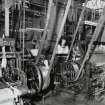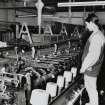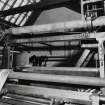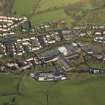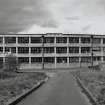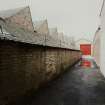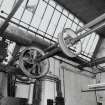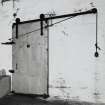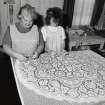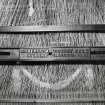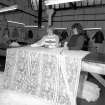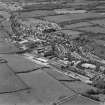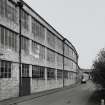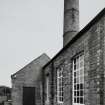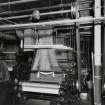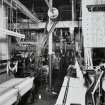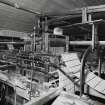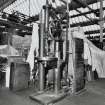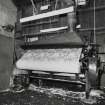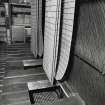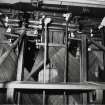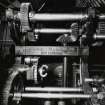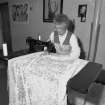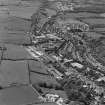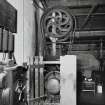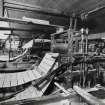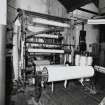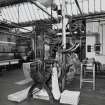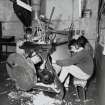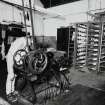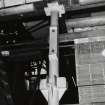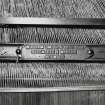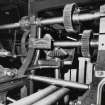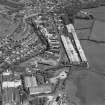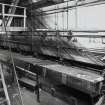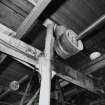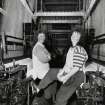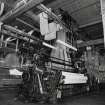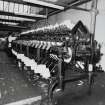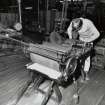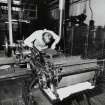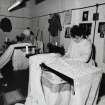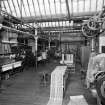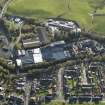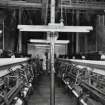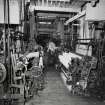Newmilns, Stoneygate Road, Morton, Young And Borland's Lace Works
Factory (Early 20th Century) (1900)
Site Name Newmilns, Stoneygate Road, Morton, Young And Borland's Lace Works
Classification Factory (Early 20th Century) (1900)
Alternative Name(s) Greenhold; Brown Street; Scotsmaid
Canmore ID 79838
Site Number NS53NW 40
NGR NS 5275 3698
Datum OSGB36 - NGR
Permalink http://canmore.org.uk/site/79838
First 100 images shown. See the Collections panel (below) for a link to all digital images.
- Council East Ayrshire
- Parish Galston
- Former Region Strathclyde
- Former District Kilmarnock And Loudoun
- Former County Ayrshire
NS53NW 40 5275 3698
See Architecture
NS53NW 5275 3698
Dating from 1901, this is the largest works in Newmilns, and is dominated by a yellow-brick three-storeyed facade with maximum use of glazing, behind which there is a group of lace and madras weaving sheds (Allan, 1979). The company, Morton Young and Borland (part of the Ayrshire Textiles group), continues to manufacture lace using Nottingham lace machines, and in on the date of visit was the only surviving manufacturer of madras in the world.
Visited by RCAHMS (MKO) 8 November 1996
C C Allan 1979
Field Visit (8 May 1990)
The firm of Morton, Young and Borland was founded in 1900, becoming Morton Young and Borland in 1905. Their Newmilns factory is situated on the south bank of the River Irvine in the Ayrshire parish of Greenholm. Their factory also dates from 1900 with additions until 1930.
At its peak in the 1920s, the factory employed up to 140 men and women but later suffered along with neighbouring textile manufacturers, reducing its payroll to only 35 employees. However, following a management buyout in 1983, the company was re-organised, thereafter operating under the new name of ‘Scotsmaid’. Production and profits have since revived to such an extent that the workforce has doubled to almost 70 men and women.
A number of lace manufacturers survive in the Irvine Valley producing window net furnishings, lace tableware and bedspreads. However, Morton Young and Borland are the only company in the world still manufacturing ‘Madras’. The company also manufactures traditional Nottinghamshire Lace, and now maintains five Nottinghamshire Lace machines. A sixth machine has recently been delivered and is currently being reassembled. In addition to these traditional products , Scotsmaid produces a wide range of polyester warp-knitted lace products.
It is Madras, however, that has made the company famous. Madras is a type of woven muslin cloth made entirely from high quality cotton yarn. The Madras trade originally stared as a handloom, predominantly, cottage industry. Along with the other textile industries, it was revolutionised by the application of power loom technology in the mid- 19th century. With the transformation of the industry. Madras production became concentrated in the West of Scotland, with important centres around Bridgeton (Glasgow), Paisley (Renfrewshire) and the Irvine Valley (Ayrshire). The origin of the name ‘Madras’ for this type of cloth is unclear.
Until the 1870s, the cloth produced was almost entirely a plain weave, but thereafter the introduction of patterns was made possible by the introduction of the Jacquard loom which used punch cards to produce intricate weaves and patterns. The market expanded. Thousands of patterns were possible with the technology with the industry reaching its peak in 1916 with 2000 looms operating in the Newmilns area. It prospered into the 1920s, the largest market being the United States of America.
The Madras trade suffered from the mid-1920s onwards, and by 1948, only ten of the 35 firms operating in the West of Scotland had survived. The industry was further reduced in the 1960s under the Cotton Board reorganisation scheme which paid manufacturers to scrap looms. Many producers took advantage of the scheme and by early 1970s, Morton Young and Borland were the only surviving Madras producers in the World. Even so, they had reduced capacity from a post-war level of 140 looms in three sheds to only 60 looms in one.
At Morton Young and Borland, madras is manufactured in a weaving shed containing about 60 looms of which 30 are currently in use. A maximum of 35 looms can be brought into use at any one time in cases of peak demand. The looms themselves are predominantly Anderson Foundry Co. machines of Glasgow, dating from the construction of the factory and the foundation of the company in 1900. The weaving shed was built especially to accommodate those looms. This is evident from the cast iron columns which have beam sockets incorporated into the castings, allowing for the construction of wooden platforms above the looms both providing access to and supporting the Jacquard patterning mechanism.
One of the most striking features of the Madras weaving shed is that it has retained its overhead line shafting power transmission system in preference to individual electric motor drive for each machine. The looms are therefore driven collectively from a single electric motor via a system of line shafts, themselves powered by rope-driven pulleys mounted in wall boxes on the south wall. Each loom is fitted with a fast and loose pulley, the machine being stared and stopped by a lever transferring the drive flat belt from one pulley to the other.
The Madras weave is a twist gauze, the twist helping to make the ground weave less liable to slip. The looms are set up with a web previously warped onto beams by a firm in neighbouring Darvel. The beams are usually 48 or a maximum of 72 inches wide. Each machine uses wither two, three of four shuttles selected from its shuttle box at any one time, the shuttles being supplied with pirns from a pirn winding machine in the next shed. The design of the Madras is woven into the ground weave of the cloth using the Jacquard patterning mechanism. Some of the weft is left floating between the pattern heads, and for this reason the Madras pattern is never clear upon leaving the loom. At this stage the cloth is immediately inspected and the drawn in rove is removed.
In order to expose the pattern, the cloth is subsequently cropped in the clipping department by a machine manufactured by AF Craig of Paisley, again dating from around 1900. The machine appears to be a simple, type of inverted, stationary lawn mower in a cast iron frame. However, in order not to damage the cloth whilst successfully cutting away the floating weft, the blades must be very accurately set. The required distance is equal to four layers of waxed brown paper on the first cutting and one layer in the second finishing with two clippings.
After clipping, the cloth is taken several stages of inspection and finishing. Repairs are carried out by hand darning. The cloth is then sent outside to finishers who clean and dye the cloth giving its distinctive ivory colour. They also pass it through a stentering machine which supplies starch and presses the cloth. The Madras is then returned to the factory where it is again inspected and repaired where necessary prior to packaging and dispatch.
Unlike the lace products in the factory, Madras is not sold as finished items such as bedspreads, curtains and tablecloths. It is usually sold to customers in a piece basis to order. Madras is an expensive, high-quality product, its greatest attraction being its high quality and the extraordinary range of patterns that are available.
Visited by Miles K Oglethorpe, RCAHMS, May 1990.
Note (20 August 2024)
History of Muslin Weaving Trade - latterly known as Madras Trade
The trade originally started s a hand loom or cottage weaving industry, daing back at least as far as the 18th century and possibly earlier. The hand loom trade was still practiced until the intervention of the power loom . The power loom was motivated by steam engines, producing larger quantities of cloth than the old hand loom.
The power looms came to Scotland in the early 1860s, and at that time the muslin trade consisted , almost exclusively , of cloths which were a plain weave , and no pattern was discernable.
Towards the end of the 1860s and early 1870s, the jacquard patterning mechanism was adapted for the power looms and factories producing jacquard patterning mechanism was adapted for the power looms and factories producing jacquard type cloths spring up in and around Glasgow and the south west of Scotland many of them being situated in the Irvine Valley which was also the Scottish centre of Nottingham Lace Curtain Machine trade.
The weaving trade expanded in leaps and bounds and it reached its heigh of development in or around 1910 up to the mid 1920s., three principle market being the USA.
Around 1925, the market started to decline when there was 35 firms producing muslin weaves and up to 2000 looms employed.
The advent of World War 2 helped to some extent to keep the trade going, as textiles of any type were in demand, but by 1948 the remining firms surviving in the Irvine valley was about 10, producing the muslin type cloth, and since then all have gone out of business with the exception of MYB who remain the sole producers of the muslin type cloth (now known as madras) in the World.
The name Madras was adopted for the particular type of weave previously referred to as 'muslin' around 1900. This was possibly because one of the larger firms in Glasgow - Strangs - did a lot of trade in Madras business in India with one of their ranges known as 'Madras' and the name stuck.
Designs proved to be good sellers so from then on all cloths made of this type of weave were called 'Madras', regardless of the design.
The Madras weave is a twist gauze, quite different from the ordinary plain one and one ground weaves. The twist makes the ground less liable to slip, and it obtained by using two reeds [on the loom] one working against the other. The design on the Madras is woven into into the ground by the use of the jacquard patterning mechanism, leaving some of the weft floating between the pattern heads. This floating weft is clipped away by a machine resembling a stationary lawn mower, leaving the pattern on the fine ground cloth.
The speed of the operation on the madras loom is exceptionally slow , up to only only 10 metres per day per machine being obtainable from a skilled weaver - each weaver having to operate two machines. This accounts for the relatively high cost of the article , and the other principal reason is that only the highest quality of yarns are used in the ground effect, in order to minimise shrinkage and slippage.
'SCOTSMAID' was the trade mark of Morton Young and Borland in 1990.
Morton, Young and Borland information sheet on the Madras Trade, c. 1990
MS/83..














































































































